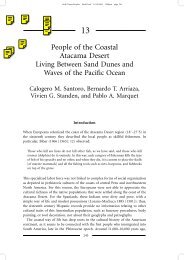Dispersal and transient dynamics in metapopulations - IEB
Dispersal and transient dynamics in metapopulations - IEB
Dispersal and transient dynamics in metapopulations - IEB
Create successful ePaper yourself
Turn your PDF publications into a flip-book with our unique Google optimized e-Paper software.
Transient <strong>dynamics</strong> <strong>in</strong> <strong>metapopulations</strong> 199subpopulations. The number of <strong>in</strong>dividuals <strong>in</strong> each population<strong>in</strong> the next generation is given by the sum of thelarvae dispersed over the entire ensemble to that particularpopulation.N ½tþ1;iŠ ¼ XMj¼0L ½t;jŠ p ½j;iŠð4ÞOn the other h<strong>and</strong>, total population abundance for themetapopulation at generation t is given by the sum of<strong>in</strong>dividuals present <strong>in</strong> the metapopulation after dispersal <strong>and</strong>prior to reproduction. Previous studies (Hast<strong>in</strong>gs & Higg<strong>in</strong>s1994; Ruxton & Doebeli 1996) have assumed dissipativeboundary conditions (but see Hast<strong>in</strong>gs 1998). This meansthat a fraction of the larvae disperse beyond the edges of theensemble <strong>and</strong> do not <strong>in</strong>fluence the <strong>dynamics</strong> of the system.It may be argued that this loss of <strong>in</strong>dividuals may lower thelocal growth rate, thus lower<strong>in</strong>g the likelihood of observ<strong>in</strong>g<strong>transient</strong> <strong>dynamics</strong>. To assess the importance of larval losswe compared, for each dispersal kernel, the effect ofdissipative vs. periodic boundary conditions. To allow easiercomparison of the results we set the parameters a ¼ 1,b ¼ 4.8 <strong>and</strong> k ¼ 7, as used by Ruxton & Doebeli (1996).Under these parameter values, isolated local populationsshow chaotic <strong>dynamics</strong>. Initial local population abundances(i.e. <strong>in</strong>itial conditions) were drawn <strong>in</strong>dependently from ar<strong>and</strong>om uniform distribution between 0 <strong>and</strong> 4. In eachsimulation, the model was iterated for 10 000 generations,<strong>and</strong> the <strong>dynamics</strong> exam<strong>in</strong>ed for the occurrence of <strong>transient</strong><strong>dynamics</strong> (Hast<strong>in</strong>gs & Higg<strong>in</strong>s 1994). This procedure wasperformed for both dispersal kernels us<strong>in</strong>g two ranges of thedispersal parameter (r), from 0.01 to 5 <strong>and</strong> from 5.01 to10.00 (with <strong>in</strong>crements of 0.01 with each range) <strong>and</strong> for twodifferent system sizes M ¼ 10 <strong>and</strong> M ¼ 50. To assess theeffect of each factor <strong>in</strong> isolation <strong>and</strong> the <strong>in</strong>teraction amongfactors (i.e. kernel, boundary, r, <strong>and</strong> lattice size) on theemergence of <strong>transient</strong> behaviour, we used a full factorialexperimental design (Qu<strong>in</strong>n & Keough 2002) consider<strong>in</strong>gthe two levels of r (r £ 5 <strong>and</strong> r > 5). All factorialcomb<strong>in</strong>ations of factors resulted <strong>in</strong> 16 different scenarios.Twenty replicates were run for each of them.To evaluate the effect of <strong>in</strong>itial conditions of localabundance on the observed results, we also carried out 50simulations with different <strong>in</strong>itial conditions for a subset ofparameter values (r), uniformly spread between 0.01 <strong>and</strong>10. We report the proportion of the 50 replicates for eachvalue of s, which exhibited <strong>transient</strong> behaviour undernormal <strong>and</strong> Laplace kernels <strong>and</strong> for both boundaryconditions.Follow<strong>in</strong>g Hast<strong>in</strong>gs & Higg<strong>in</strong>s (1994) <strong>and</strong> Saravia et al.(2000), <strong>transient</strong> <strong>dynamics</strong> were identified by not<strong>in</strong>g theexistence of abrupt <strong>and</strong> spontaneous changes betweendifferent dynamic regimes with time scales of hundreds ofiterations (meso<strong>transient</strong>s) <strong>and</strong> with a time scale greater thanone thous<strong>and</strong> iterations (super<strong>transient</strong>s). Detection of thesechanges was carried out by calculat<strong>in</strong>g the ratio of variances(RV) between two adjacent halves of a slid<strong>in</strong>g w<strong>in</strong>dow ofsize W (Saravia et al. 2000). Both RV <strong>and</strong> W weredeterm<strong>in</strong>ed empirically to allow detection of super<strong>transient</strong>s(RV ¼ 10, W ¼ 1000) <strong>and</strong> meso<strong>transient</strong>s (RV ¼ 20,W ¼ 100). For a given simulation, <strong>transient</strong> length wasdef<strong>in</strong>ed by the time <strong>in</strong>terval at which the maximum value ofRV was observed. The changes <strong>in</strong> metapopulation <strong>dynamics</strong>were corroborated by the <strong>in</strong>spection of the temporal<strong>dynamics</strong> <strong>and</strong> return maps (Hast<strong>in</strong>g & Higg<strong>in</strong>s 1994; Saraviaet al. 2000).RESULTSIn agreement with previous studies, we observed super<strong>transient</strong><strong>dynamics</strong> <strong>in</strong> this simple metapopulation model(Fig. 2a). These changes occurred once or several times <strong>in</strong>Figure 2 Example of <strong>dynamics</strong> for the total metapopulationabundance observed for: (a) normal dispersal kernel with periodicboundaries <strong>and</strong> r ¼ 9.01. (b) Laplace dispersal kernel withdissipative boundaries <strong>and</strong> r ¼ 8.44. (c) A subset of the <strong>dynamics</strong>shown <strong>in</strong> (b). In all simulations only the dispersal parameter value<strong>and</strong> boundary conditions were changed <strong>and</strong> the follow<strong>in</strong>gparameter values were used: a ¼ 1, b ¼ 4.8, k ¼ 7, M ¼ 50.Ó2003 Blackwell Publish<strong>in</strong>g Ltd/CNRS
















